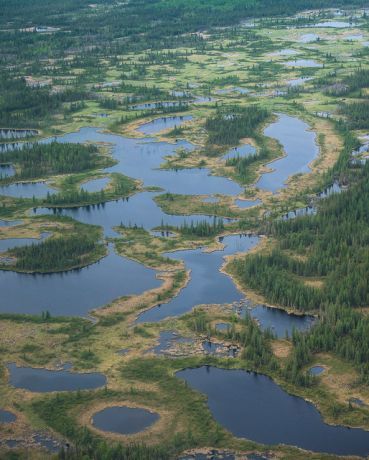Features
You are here
Toxic tar sands mine approved “in the public interest”

August 15, 2019
A tar sands mine that will destroy an area of 240 square kilometres has just been approved. The Teck Resources’ Frontier open pit mine will cover an area greater than the cities of Vancouver, Burnaby and New Westminster combined. The mine will extend to within 30 km of Wood Buffalo National Park.
At the end of July, the joint Review Panel Established by the Federal Minister of Environment and Climate Change and the Alberta Energy Regulator released its report. In it they wrote, ”We find that the project is likely to result in significant adverse environmental effects to wetlands, oldgrowth forests, wetland- and old-growth-reliant species at risk, the Ronald Lake bison herd, and biodiversity. The project is also likely to result in significant adverse effects to the asserted rights, use of lands and resources, and culture of indigenous groups who use the project area. The proposed mitigation measures have not been proven to be effective or to fully mitigate project effects on the environment or on indigenous rights, use of lands and resources, and culture.”
When combined with other existing or planned tar sands mine, the panel found that it was, “likely to result in significant adverse cumulative environmental effects to wetlands, old-growth forests, wetland- and old-growth-reliant species at risk, fisher, Canada lynx, woodland caribou, the Ronald Lake bison herd, and biodiversity.”
The panel also predicts that this project will increase greenhouse gas emissions in the production of oil from the tar sands by 5.4% more per year than in 2016. This ignores the gasses produced by burning the oil. The mine is expected to remain in production for 41 years after it opens. The Intergovernmental Panel on Climate Change has determined that we need to reduce our greenhouse emissions by more than 45% in the next decade, and bring them to zero in 30 years.
The proposed mine site is currently covered by old growth forest, home to bison, caribou, rare plant species and numerous small lakes. The project overlaps with the range of the Ronald Lake bison herd. These bison are genetically distinct from the herd in Wood Buffalo National Park, and unlike them, do not carry bovine tuberculosis or brucellosis. The panel found that there is a good chance that the mine would force the Ronald Lake bison north where they would come in contact with the diseases carried by the herd in the park. The panel believes this, “would have significant consequences for the herd and the asserted rights, use of lands and resources, and cultural practices of indigenous communities who are connected to the herd.”
The panel predicts that the company’s plans for reclaiming the site will result in a return of the old growth forest after 2180. The panel found that “this implies a loss of habitat for many species of old-growth-reliant species, including species at risk, until at least 100 years following closure.”
But that won’t be the same forest we have now, the panel found that, “plant species that are unique to peatlands and rare plants are permanently lost. The effect is long term, extending past closure.” Despite Teck Resources plans for reforesting, the panel noted that “The current state of reclamation in the oil sands region is such that less than 25% of the disturbances have been reclaimed. In addition, the presence of tailings deposits on oil sands sites may delay reclamation timelines, thus delaying development to old-growth status.” In other words the estimate of a return to old growth forest by 2180 is probably much too optimistic.
Seventeen First Nations and Métis groups presented to the panel. Although several Indigenous groups have reached agreements with Teck Resources, “in general the panel found that the project effects on use of lands and resources for traditional purposes, their cultural and physical heritage, and asserted rights will be adverse and significant for those groups close to the project.”
Given how much damage the panel expects this project to create, why would the panel approve it? In their own words, “Although we find that there will be significant adverse project and cumulative effects on certain environmental components and indigenous communities, under our authority as the AER, we consider these effects to be justified and that the Frontier project is in the public interest. “
For the oil industry executive appointed to lead the panel, “the public interest” starts and ends with the profits of Canadian companies. Despite hundreds of submissions, years of work and a report that runs more than 1200 pages long, this was always going to be the conclusion. Now this recommendation goes to the Federal Liberal Government who will approve it just like they approved the Trans-Mountain pipeline. But the public interest of the 99% is not the same as the interests of the 1%. Good jobs, decent wages and a livable planet are all harmed by dedicating our collective wealth to expanding the tar sands. There are alternatives but they’ll never come through parliament.
For example, the panel believes Teck Resources’ claims that the project will create thousands of jobs and will pay more than $70 billion in taxes to various levels of governments. Coincidentally, Trudeau’s government plans to spend at least that amount building 15 war ships. We could cancel the ships, and draw back from Canada’s endless wars, and the savings would cover the projected taxes on this mine. And we get the money a lot quicker, the mine will pay taxes over 41 years, but the $70 billion spending on war ships is supposed to take only 25 years.
Teck Resources and all the rest of Canadian Capitalism will never let us vote away their hundreds of billions “invested” in the tar sands. The only climate plan that will work is if we take it from them.
Section:










